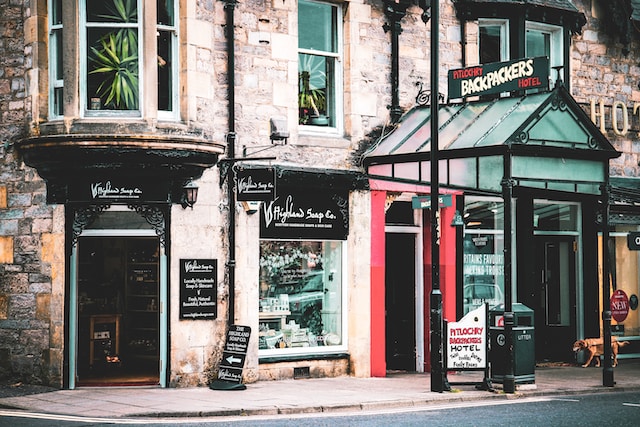Scotland boasts a vibrant restaurant scene that spans the international spectrum as well as exquisite local fare – from haggis (made with minced lamb lungs, heart and liver mixed with oatmeal and then stuffed into sheep stomachs) to bacon butties (a sausage sandwich), there is something tasty on every menu in Scotland.
Haggis
Scotland may not be as culturally vibrant as some European nations, but its cuisine remains rich with tradition. Scots’ hearty dishes were developed out of necessity when living an unpredictable and mobile lifestyle; typically featuring oatmeal or potatoes mixed with meat from beef, lamb or venison sources.
Haggis is Scotland’s national dish, an irresistibly tasty pudding composed of sheep’s pluck (lungs, liver, and heart), oatmeal, onion, and spices. Originally prepared inside a sheep’s stomach for optimal results; nowadays most commonly sold and prepared using synthetic sausage casings for easier consumption. Haggis is best enjoyed with classic sides such as bashed neeps and tatties (rutabagas and mashed potatoes), lashings of whisky sauce – it should not be missed when visiting Scotland! It should not be missed when traveling there!
Bridies, also known as Scottish empanadas or Cornish pasties, are an iconic Scottish snack made up of minced steak, suet, onions folded into shortcrust semicircle pastry and folded over for easy eating at football or rugby games. They’re often an inexpensive and tasty meal option to bring along!
Fish supper is an enjoyable light meal option; essentially a fish and chips dish prepared using haddock deep-fried in batter, it can be found at many pubs called “fish and chip shops” across Scotland. Pair yours with Irn-Bru or Scotch whisky; they make great accompaniments when celebrating Robert Burns Night or Hogmanay!
Bangers and Mash
Bangers and mash are a timeless staple across the UK, but particularly beloved in Scotland. Choose from free-range and grass fed Scottish pork sausage varieties like pork and cheese or venison and peppers before pairing with one of these options of mash: monster (plain mashed potatoes with butter), mustard mash or champ with spring onions – each served alongside its own special gravy sauce!
Haggis is one of Scotland’s signature dishes – a tasty steaming stew consisting of minced sheep’s pluck (liver, lungs and heart), oatmeal and spices – served in its animal’s stomach lining and eaten year-round – but especially popular on Burns Night on January 25th to honor poet Robert Burns. For those unsure whether haggis is for them vegetarian versions can also be found using mushrooms and herbs instead of haggis!
Stovies are an easy, affordable working class meal consisting of stewed potatoes cooked in fat (usually lard or dripping ) along with meat, vegetables and protein-rich ingredients to provide ample nourishment after long days mining, lumbering or fishing.
Dessert options in Scotland vary; from porridge and Scottish tablet (butter, sugar and condensed milk baked together to create a chewy sweet block) to delectable layered desserts such as cranachan (toasted oats topped with raspberries, double cream, honey and whisky) and crowdie cheese (Scottish cream cheese with chutney and smoked salmon).
Scotch Broth or Cock-a-Leekie
Scottish chefs are masters at crafting delicious soups and broths; one of their oldest recipes (from F Marian McNeill in The Best of Jane Grigson), by F Marian McNeill himself, ranks them “first among all European nations in making such honest broths.” One such classic made with leeks and potato is often known as Johnstone’s Leekie Latte; her take added beef as she believed this made for a better dinner meal (Johnstone published her version in 1929 as The Scots Kitchen: Its Traditions Lore with Old-time Recipes): Johnstone believed “if meat be the foundation of a great dinner then add beef for leekie.”
Black pudding, an iconic Scottish dish, may be off-putting to those unfamiliar with its makeup. Made of congealed blood and oatmeal mixed together into a kind of savory sausage form, you’ll find black pudding served throughout Scotland from basic chippies and pubs to fine dining restaurants as well as breakfast offerings at hotels and B&Bs.
Haggis, neeps and tatties is perhaps Scotland’s signature dish and should be celebrated annually on Rabbie Burns Night (January 25) (Rabbie Burns was an 18th century poet born in 1759). For those not quite ready for haggis but want a taste of classic Scottish fare, try bangers and mash at a traditional Scottish pub or restaurant featuring an open fire.
Porridge
Though few Scots start their day with porridge these days, this hearty oatmeal dish remains an iconic icon of Scotland. This tradition dates back to Scotland’s rural origins when people needed to bring food with them on long journeys and stored energy through porridge meals that provide nourishment and high energy content for hours on end.
Today, oatmeal is often prepared using milk; however, its original version was simply made using water and salt. You can still enjoy a bowl of this tasty treat by boiling rolled oats in a pan; once ready to be served you can adjust how much or little milk or additional ingredients like brown sugar or dried fruits you want added as desired.
Serve your porridge with a splash of milk for added sweetness, or combine with slices of banana and brown sugar to sweeten it further. Milk helps cool the steaming bowl down, protecting your tongue from burning while you eat standing up – an ancient practice believed to have originated among farmers who needed to keep up with work while dining on this staple food.
Haggis, Scotland’s national dish, makes an excellent breakfast choice. Composed of finely chopped lungs, heart and liver combined with onions and oatmeal before being stuffed into the stomach of a sheep and cooked, haggis is usually enjoyed alongside champit tatties (mashed potatoes) and bashed neeps (turnips or swede).








